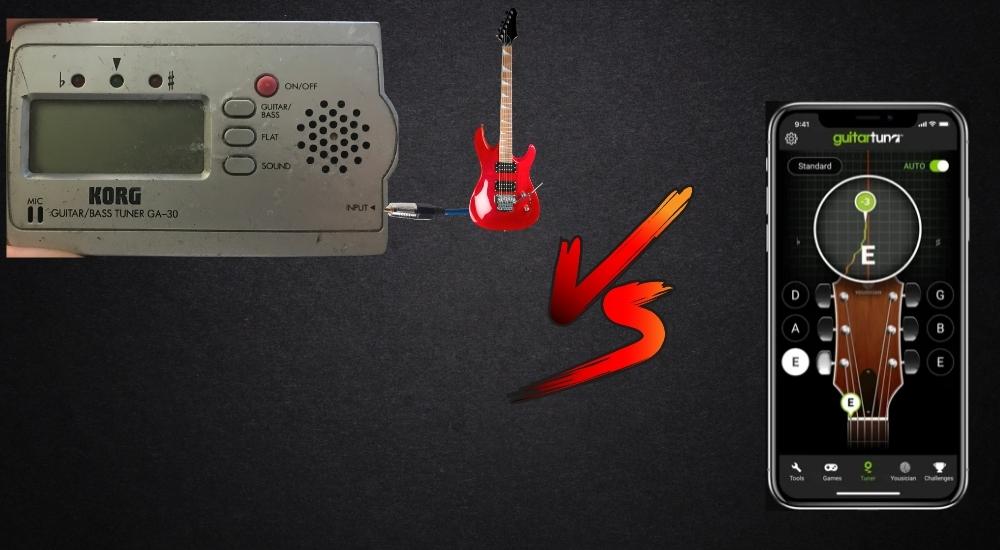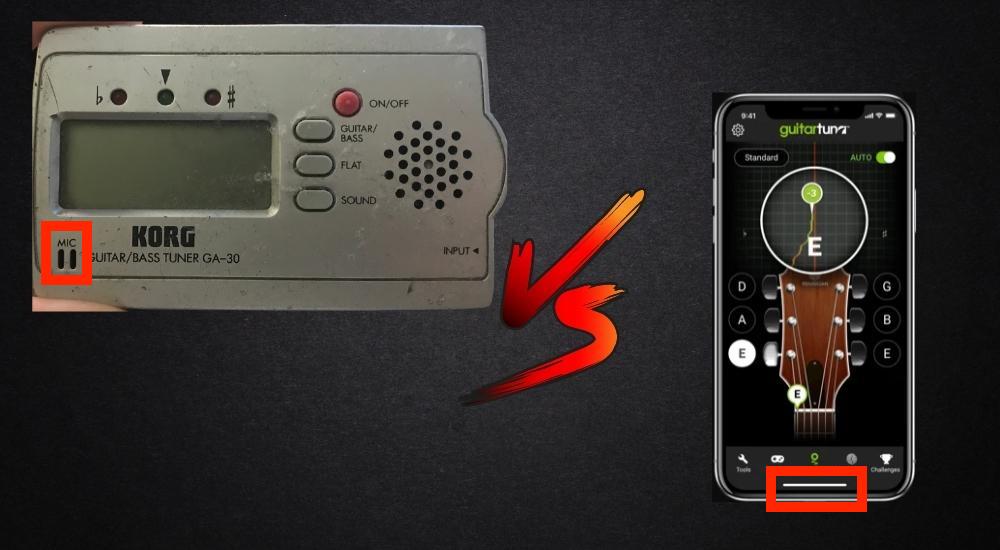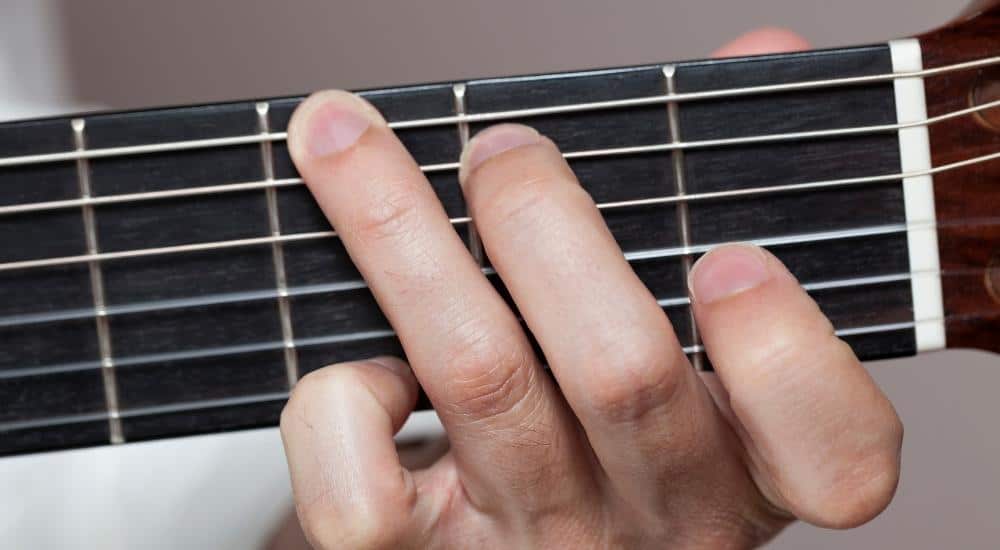Ever since the iPhone came out and apps became huge on the App Store, guitar tuners have existed in some form or another. Not all of them were great, but some of them are now pretty decent, even though they’re not as good as real tuners like one from Korg or a floor pedal like what Boss makes with the TU-3.
I would argue that downloading an application like Guitar Tuna is certainly worth the space on your computer’s little hard drive, but is it as good as a tuner from Korg? Probably not. The same thing can be said about the tuners that you’ll find in the App Store or from Google Play. Simply put…
Guitar tuner applications can tune a guitar with an error margin of 1-3 cents, however, the most capable human ear can only notice a change in pitch between 4-7 cents. That said, to achieve this level of accuracy, the device must be connected to an external mic or the guitar to an audio interface.
In other words, guitar tuner applications are good enough to tune a guitar in a quiet room with no one else around. If you’re a busy musician, however, and you have to tune up on stage, you’ll need a tuner that relies on direct input so the environment won’t get in the way. In this article, I’m going to show you the results of a test I conducted using the Guitar Tuna application in comparison to the Korg Tuner that I own.
The Experiment – Are Guitar Tuner Applications Accurate?
For both tests, I used an electric guitar rather than an acoustic guitar, where one was plugged into the Korg Tuner and compared to the Guitar Tuna app, and the other test was unplugged with the Korg Tuner in comparison to the Guitar Tuna application.
What I did was I plugged my guitar into the Korg tuner and then ran the Guitar Tuna application at the same time to see the discrepancies between the pair.
Furthermore, I also ran a test to check Korg’s built-in microphone – which is meant for tuning acoustic guitars – against the Guitar Tuna application. You can check out the YouTube video above to see the test between both tuners.
What I discovered is exactly what I noted in the first part of this article: Guitar Tuna – which is easily one of the most popular tuners for guitars on the iPhone – is fairly accurate. It’s certainly accurate enough, but there’s no question that my classic Korg Tuner is a little bit more sensitive.
Results Of The Test – Korg Tuner Vs Guitar Tuna
Input Korg Tuner Versus Guitar Tuna Microphone

For this test, I had the Korg tuner plugged into the regular input with a 1/4 jack as you would normally use and I compared it to the Guitar Tuna application. As you would expect, the input tuner worked better as the Guitar Tuna reported perfect tuning at times when it was not.
The phone application seems to pick up on higher notes with relative ease, and it was pretty much right on the money in terms of the high E-string as well as the B-string. However, I started to run into issues with the G string. My Korg Tuner was telling me I was a bit sharp, whereas the Guitar Tuna was telling me I was right on the money.
The D-string was relatively on the money as well, as was the A string, however, when I got down to the bottom E-string, my Korg Tuner was telling me I was a bit flat, whereas the Guitar Tuna application kept telling me I was perfectly in tune.
You might say that this is a fixed game considering one is plugged in and the other one is not, but the fact of the matter is that most people will be using the Guitar Tuna app in this way unless they’re using an iRig HD 2 (on my Product Page) to connect their guitar to their iPhone.
Korg Tuner Microphone versus Guitar Tuna Microphone

This is where we get more of an honest comparison because now we’re comparing two microphones. That said, this particular Korg tuner is incredibly old and the microphone in it is as well. I imagine the iPhone microphone is much better quality than this 15-year-old Korg tuner.
Results
The high E-string on the Korg tuner reported that I was perfectly in tune, whereas the Guitar Tuna application stated I was a bit sharp.
For the B-string, the Korg tuner stated I was hovering around perfectly in tune (however, It’s worth noting that even the Korg tuner was struggling to pick up on the guitar string signal because it’s no longer plugged in).
The Guitar Tuna application, however, was reporting that I was still a bit sharp. For the G-string, the Guitar Tuna application wasn’t even picking up the signal at all from my guitar.
It was saying that I was hovering on E, and wasn’t even picking up the proper pitch of the strings, whereas the Korg Tuner was saying that I was perfectly in tune on the G-string.
For the D-string, the Korg tuner reported that I was hovering around perfectly in tune, sometimes altering between slightly flat and perfectly in tune, whereas the Guitar Tuna application reported that I was a bit sharp.
For the A-string, again, the Guitar Tuna application was reporting that I was a bit sharp, whereas the Korg tuner was stating that I was perfectly in tune, however, it appeared to be much closer. Depending on how hard I hit the string, determined whether the tuner would pick up if I was sharp or flat, with both tuners.
For the bottom E-string, the Korg Tuner was actually struggling to hear the note, I think because of the buzzing on my low E-string. When I finally got it to register around perfectly in tune, the Guitar tuna, again, was saying that I was a bit sharp.
The Next Test – Open G Chord on Korg And Guitar Tuna (Plugged In)

For this part, we’re going to play a G Chord on the Guitar tuned using the Korg Tuner plugged in, in comparison to the Guitar Tuna application tuned perfectly, just to see how they sound. For this test, I found that the difference – at least to my ear – wasn’t big enough for me to be concerned with.
Also, if a string is a tiny bit sharp or a tiny bit flat, it’s really not going to make the biggest difference in my opinion. If your string is out by a cent or two, the sound it makes won’t be terribly out of tune.
As I argued in my article on why the B-string always sounds out of tune, we use the 12-Tone Equal Temperament system to tune our instruments, so naturally, some of the strings on the guitar are out by just a couple of cents.
A couple of cents won’t be the difference between someone thinking your playing sounds terrible, unless you’re trying to impress elitists or other hard-to-please individuals.
Are Guitar Tuner Applications Good?
I would argue the same point that I mentioned at the beginning of the article: the Guitar Tuna application is fairly accurate, but it’s not as good as a traditional tuner.
I would say that for an iPhone application, Guitar Tuna is definitely worth picking up on your phone, in case you’re on the road and you quickly need to tune your guitar, or you left it back at home. It works fine for what you get.
However, I wouldn’t recommend purchasing the subscription for $3 a month or whatever it is, because, for that money, you could just pick up a Chromatic tuner from a company like Korg and be perfectly tuned up all of the time.
Moreover, there are even better options out there for tuning your guitar, like guitar tuner pedals such as the Boss TU-2 which fit on your pedalboard and are hooked into your gear, that way it’s ready to go and you don’t need to pull out your phone or anything. You also won’t have to worry about extraneous noises either.
It’s worth noting that the Korg tuner I was using is actually around 10-12 years old, I believe. Since then, I’m sure the microphone system in Korg’s products, among other tuners, has improved considerably.
Repeating what I said above, there’s nothing wrong with using an iPhone application to tune your guitar. Is it perfect before a studio session? Probably not, but it’s going to work just fine for your everyday use.
However, as technology gets better and better all of the time, including the sensitivity of the microphones in our phones as well as the speakers, I’m sure that someday the opposite case will be true.
But then, on the other hand, if the microphones increase in quality in the phones, then the same thing could be said for the traditional tuners as well, so it’s hard to say exactly what the future will hold, but I think that professional-grade tuners meant specifically for tuning an instrument will always reign supreme.
What Other Tuners Should You Get?
There are a few good options out there for a tuner, including a traditional Korg tuner, as well as the Snark clip-on Tuner. I currently have 5 tuners in my home. I have the Korg tuner that I showed you earlier, another black Korg tuner, the Snark Clip-on tuner, as well as the Boss TU-2.
If you include the Blue Cat Audio Hot Tuna which is a plugin in my DAW, it brings the total to 5. Even though this seems like overkill, I use all of these.
I use the Hot Tuna from Blue Cat Audio when I’m plugged in directly to Garageband, I use the Snark while I’m noodling, and I use the Boss TU-2 when I’m playing with my amp.

 Written By :
Written By :